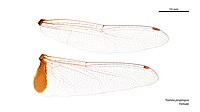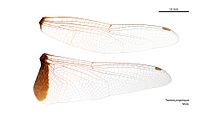Tramea transmarina
| Tramea transmarina | |
|---|---|

| |
| Male | |
| Scientific classification | |
| Domain: | Eukaryota |
| Kingdom: | Animalia |
| Phylum: | Arthropoda |
| Class: | Insecta |
| Order: | Odonata |
| Infraorder: | Anisoptera |
| Family: | Libellulidae |
| Genus: | Tramea |
| Species: | T. transmarina
|
| Binomial name | |
| Tramea transmarina | |

| |
| Synonyms | |
|
Tramea samoensis (Brauer, 1867) | |
Tramea transmarina, known as the red glider or northern glider,[3] is a species of dragonfly in the Libellulidae family. The type locality for Tramea transmarina is Fiji, but subspecies are found in the islands of the Pacific, north-eastern Australia and Southeast Asia.[4][3]
Taxonomy[edit]
The following names are considered to be alternative names to Tramea transmarina Brauer, 1867:[4]
- Trapezostigma euryale Selys, 1878
- Tramea transmarina intersecta Lieftinck, 1975
- Tramea propinqua Lieftinck, 1942[a]
- Tramea samoensis Brauer, 1867
Description[edit]
Tramea members typically have coloured bases to their hindwings. When they fly, this creates the impression of them carrying bags at the top of the abdomen; hence they are commonly known as saddlebags gliders. In general, adult males have a dark thorax and bright abdomen.
Wings[edit]
-
Mating pair
-
Female
-
Male
References[edit]
- ^ Wilson, K.D.P.; Rowe, R.; Marinov, M. (2020). "Tramea transmarina". IUCN Red List of Threatened Species. 2020: e.T167183A83375536. doi:10.2305/IUCN.UK.2020-1.RLTS.T167183A83375536.en. Retrieved 20 November 2021.
- ^ Brauer, F. (1867). "Beschreibung neuer exotischer Libellen aus den Gattungen Neurothemis, Libellula, Diplax, Celithemis und Tramea". Verhandlungen der Zoologisch-Botanischen Gesellschaft in Wien. 17: 3–26 [21] – via Biodiversity Heritage Library.
- ^ a b Theischinger, Günther & Hawking, John (2006). The complete field guide to dragonflies of Australia. CSIRO Publishing. ISBN 0-643-09073-8.
- ^ a b Schorr, Martin; Lindeboom, Martin & Paulson, Dennis. "World Odonata List". University of Puget Sound. Retrieved 14 March 2015.
- ^ Schorr, Martin; Paulson, Dennis. "World Odonata List". Slater Museum of Natural History. University of Puget Sound. Retrieved 24 February 2017.
- ^ "Species Tramea propinqua Lieftinck, 1942". Australian Faunal Directory. Australian Biological Resources Study. 2012. Retrieved 20 February 2017.




